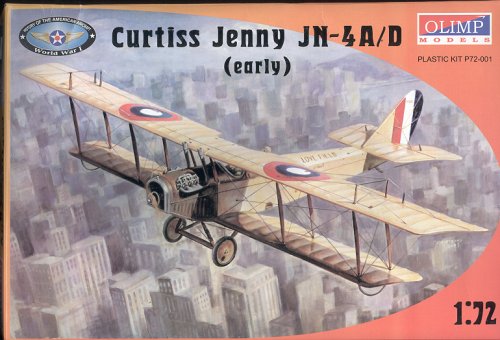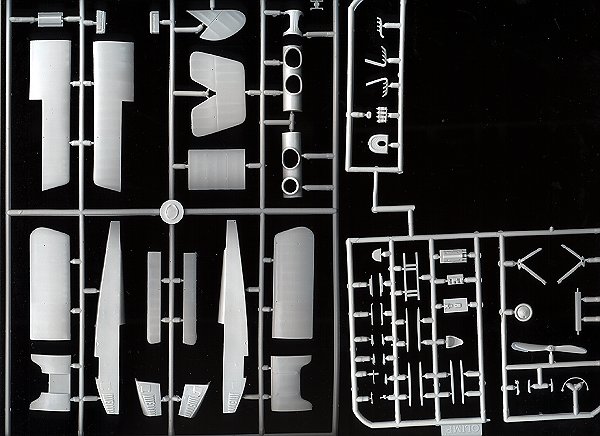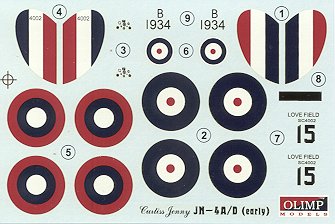
|
KIT: |
Olimp Models 1/72 JN-4A/D 'Jenny' |
|
KIT # |
72001 |
|
PRICE: |
$ |
|
DECALS: |
two options |
|
REVIEWER: |
Scott Van Aken |
|
NOTES: |

|
HISTORY |
The JN-4 appeared during July of 1916. It was virtually identical to the earlier JN-3. The first version, the JN-4A, was sold to not only the US Army, but to the British and to private pilots. Many of the Curtiss flying schools used the JN-4A. The A model was the first to use the distinctive 'Jenny' rudder. The JN-4D was introduced in July 1917 and differed from the A version in having a cut-out on both upper and lower wings near the fuselage. With America's entry into the war, large scale production of all variants of the JN-4 were made. Eventually over 6,000 were produced, with production of the JN-4D lasting until January 1919 when all subsequent orders were cancelled.
|
THE KIT |

This is the first kit of a new company from Ukraine called Olimp Models. Olimp means Olympic in Russian. They have decided to start out with one of the most famous American aircraft of WWI, the ubiquitous Curtiss 'Jenny'. A very wise choice for two reasons. One is that WWI seems to be undergoing a renewed interest in 1/72 model builders. Secondly, there are many variants of the Jenny that will allow for several boxings. In fact, according to the side of the box, no fewer than five kits will be done.
As with all multi-variant kits, there are common sprues to which the additional bits are added depending on what is being kitted. That is quite true of this particular kit. For what is really a short run kit, it is very well done. The first thing I noticed is that there is quite a lot of mold release oil on the parts, so a good washing in warm, soapy water will be the first thing you'll need to do. The level of detailing is quite good. Though the detail itself is a bit soft when compared to kits by Hasegawa or Italeri, it is well up to the levels of most similar companies. I noted no sink areas, Ejector pin marks only on the inside of large pieces, and only a tad bit of flash, most noticeable on the prop. Fabric representation is quite good and not overly accentuated.
There are a myriad of small bits on two identical sets of sprues. You'll have several extra bits that have been duplicated, such as the props and radiators, for example, but this is really the easiest way to do things when you need multiples of the same part. It also means that there are bits on some sprues that are for later kits that will not be needed on this one.
The cockpits are relatively complete with floor, seats, stick and rudder pedals. There is some faint detail on the inside of the fuselage. An upper engine section is provided. The wings are each in three sections. There are two optional upper wing center sections depending on if you are doing an A or D version. This seems to be the only difference between the two. As you might expect, there are a lot of struts on this one as well as the various 'towers' on the upper wing for the rigging.
 Instructions
are very nice with a historical section in both English and Russian.
There is a parts ID guide with those bits not used clearly marked. This
is followed by seven well drawn construction sequences. These show any
optional bits as well as color information. The color guide provides a
common name and paint numbers for Humbrol, Model Master and Revell
paints. No rigging guide is offered, though one can easily use the box
art in that respect. Markings are for a JN-4D attached to Love Field in
Texas during 1918 and is the box art aircraft. The other is a JN-4A of
the Royal Naval Air Service in 1918. It is painted in Dark Green uppers
with linen undersides and Service Brown areas around the cockpit. Decals
are very well done and quite glossy. Instrument decals are provided, but
the white background is a bit off register. This does not affect the
roundels or rudder stripes that I can see.
Instructions
are very nice with a historical section in both English and Russian.
There is a parts ID guide with those bits not used clearly marked. This
is followed by seven well drawn construction sequences. These show any
optional bits as well as color information. The color guide provides a
common name and paint numbers for Humbrol, Model Master and Revell
paints. No rigging guide is offered, though one can easily use the box
art in that respect. Markings are for a JN-4D attached to Love Field in
Texas during 1918 and is the box art aircraft. The other is a JN-4A of
the Royal Naval Air Service in 1918. It is painted in Dark Green uppers
with linen undersides and Service Brown areas around the cockpit. Decals
are very well done and quite glossy. Instrument decals are provided, but
the white background is a bit off register. This does not affect the
roundels or rudder stripes that I can see.
|
CONCLUSIONS |
It is great to see a new company on the market. Especially one that is offering such a nice line-up of kits. I do hope they do well as I can see a series of Curtiss fighters on the horizon. Because of all the small pieces and the rather involved rigging, it is recommended that one have some experience with WWI aircraft before diving into this one.
|
REFERENCES |
Curtiss Aircraft 1907-1947 by Peter M Bowers, 1987, Naval Institute Press
Kits courtesy of Olimp Models. Visit their website for more information on these kits.
If you would like your product reviewed fairly and fairly quickly by a site that has nearly 250,000 visitors a month, please contact me or see other details in the Note to Contributors.